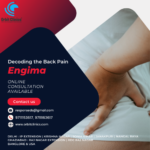Unraveling Back Pain: Debunking Myths and Discovering Truths

Written by
Dr. Deepak Sharma
BHMS, MD, Ph.D. (Scholar)
Homeopathic Physician and Educator
Founder – Orbit Clinics (World Class Homeopathic Clinics Worldwide)
Introduction:
Back pain is a widespread health issue affecting millions of people worldwide. Despite its common occurrence, numerous misconceptions persist about back pain. This article aims to debunk some of the most prevalent myths and offer evidence-based information to help individuals better comprehend and manage this condition.
Myth 1: Bed Rest is the Ultimate Cure for Back Pain
Fact: Although rest can temporarily relieve acute back pain, extended bed rest might worsen the issue. Studies show that maintaining moderate physical activity often leads to quicker recovery and a lower risk of chronic pain. Participating in low-impact exercises, like walking or swimming, can strengthen muscles supporting the spine, reducing pain and preventing future episodes.
Myth 2: Back Pain Always Results from an Injury
Fact: While injuries can cause back pain, numerous other factors contribute to the condition. Poor posture, muscle imbalances, obesity, stress, and underlying health conditions, such as arthritis, can all cause or worsen back pain. Identifying and addressing these root causes is essential for effective pain management and prevention.
Myth 3: The Spine is Fragile and Easily Damaged
Fact: The human spine is an incredibly resilient and robust structure, designed to support and protect the sensitive spinal cord. Although certain activities or traumas can damage the spine, it generally withstands significant stress. Regular exercise and proper lifting techniques help maintain the spine’s strength and flexibility, ultimately reducing the risk of injury.
Myth 4: Pain is the Sole Symptom of Back Problems
Fact: Back pain is a primary symptom of spinal issues, but other symptoms may also occur. These can include numbness, tingling, weakness, or changes in bowel or bladder function. Closely monitoring these additional symptoms can help healthcare professionals more accurately diagnose and treat the underlying causes of back pain.
Myth 5: Surgery is the Sole Solution for Chronic Back Pain
Fact: Although surgery is sometimes necessary for severe cases, it is not the only option for managing chronic back pain. Conservative treatments, such as physical therapy, medication, and lifestyle modifications, are often the first line of defense against back pain. In many cases, these non-invasive therapies effectively alleviate pain and improve function, allowing patients to avoid surgical intervention.
Myth 6: Lifting Heavy Objects Will Inevitably Lead to Back Pain
Fact: While lifting heavy objects improperly can contribute to back pain and injury, adopting proper lifting techniques and body mechanics can significantly reduce the risk. Bend your knees and hips, keep the load close to your body, and engage your core muscles when lifting heavy objects. Regular strength training can also improve muscle support and stability, reducing the risk of back injury.
Myth 7: All Back Pain Necessitates Medical Intervention
Fact: Often, back pain can be effectively managed with self-care measures like over-the-counter pain relievers, heat or ice therapy, and gentle stretching exercises. However, it is crucial to seek medical attention if your pain is severe, persistent, or accompanied by other symptoms such as fever, weakness, or numbness.
Myth 8: Thin People Are Less Prone to Back Pain
Fact: While maintaining a healthy weight can help prevent and manage back pain, being thin does not guarantee immunity from this condition. Factors like muscle imbalances, poor posture, and sedentary lifestyles can contribute to back pain in individuals of all sizes. Ensuring proper spinal alignment and engaging in regular exercise can help promote a healthy back, regardless of your weight.
Myth 9: Exercise Should Be Avoided if You Have Back Pain
Fact: Contrary to this belief, suitable exercise can help alleviate and prevent back pain by strengthening muscles supporting the spine, improving flexibility, and promoting circulation. It is crucial to consult a healthcare professional before starting any exercise program, especially if you have pre-existing back issues. They can help recommend specific exercises and modifications tailored to your individual needs and limitations. Avoid high-impact activities that could worsen your condition, and focus on low-impact exercises, such as swimming, walking, yoga, and Pilates.
Myth 10: Back Pain Is an Inevitable Part of Aging
Fact: Although back pain is more common in older adults, it is not an unavoidable consequence of aging. Many age-related changes, such as reduced muscle mass, decreased bone density, and diminished flexibility, can contribute to back pain. However, engaging in regular exercise, maintaining a healthy weight, and practicing good posture can help prevent or alleviate back pain at any age.


